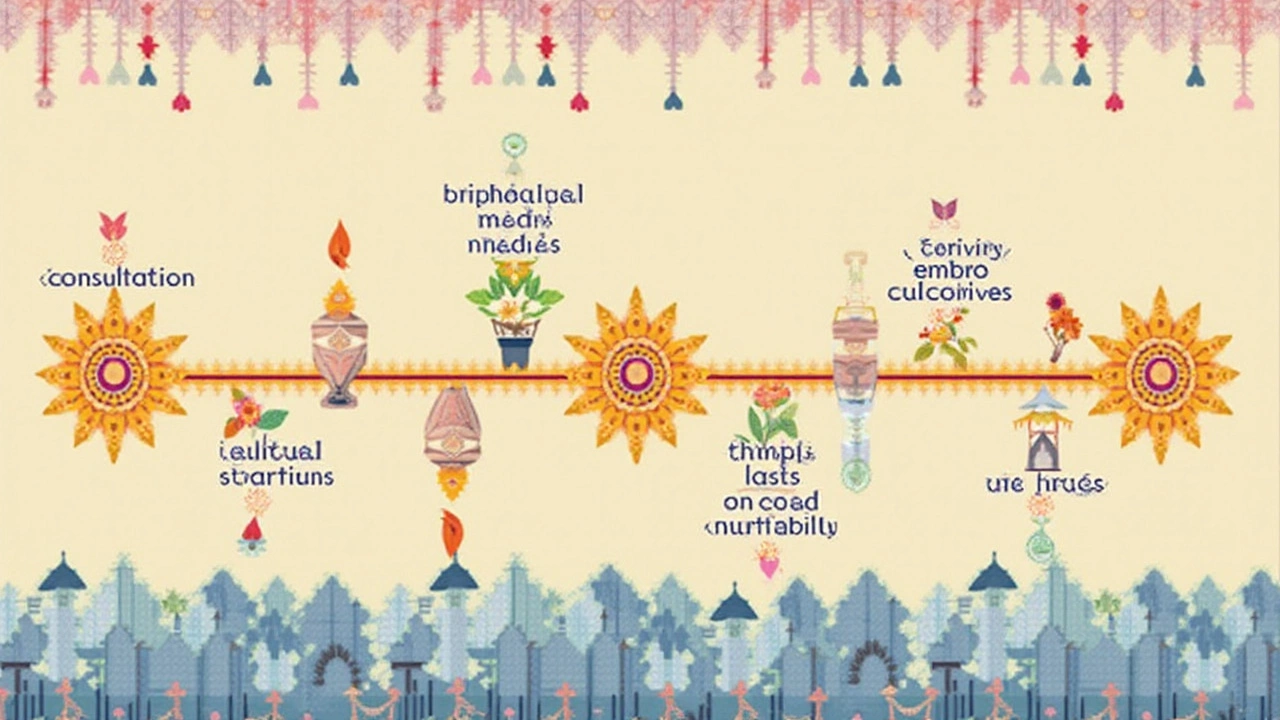Embarking on the journey of in vitro fertilization (IVF) can feel both exciting and daunting. For many, understanding the timeline of this process is a crucial first step. Each stage of IVF holds its unique challenges and triumphs, making it essential to grasp the details and intricacies involved.
From evaluating health with initial consultations to carefully timed embryo transfers, every phase of IVF requires patience and precision. Navigating this path requires awareness of both the common timelines and the personal variability influenced by individual health factors. As potential parents look forward to realizing their dreams, knowledge becomes an empowering tool in the pursuit of parenthood.
- Initial Consultations and Health Assessments
- Ovarian Stimulation and Egg Retrieval
- Fertilization and Embryo Development
- Embryo Transfer and Implantation
- Factors Influencing IVF Duration
Initial Consultations and Health Assessments
Embarking on the path of IVF treatment begins with thorough initial consultations and health assessments. This foundational step is pivotal in shaping the entire fertility journey and is designed to paint a comprehensive picture of the individual or couple's reproductive health. During these consultations, fertility specialists delve deep into medical histories, lifestyle factors, and the unique nuances of one's reproductive system. It's not merely about ticking boxes but about creating a tailored approach that increases the likelihood of success. Patients often find these sessions informational, albeit somewhat overwhelming, as they absorb essential details and make sense of unfamiliar medical terminologies.
The process typically initiates with a series of diagnostic tests. For women, these may include blood tests to assess hormone levels, which are indicative of ovarian reserve and overall fertility health. Imaging studies, such as ultrasounds, play a crucial role in evaluating reproductive organs like the uterus and ovaries. On the other hand, male partners often undergo semen analysis to examine sperm count, motility, and morphology. Such comprehensive diagnostics ensure any factors that could influence the IVF process are identified early. A customized treatment plan can then be recommended, crafted to bypass potential hurdles on the road to conception.
During these consultations, the emotional and psychological aspects are equally important. Many clinics offer support and counseling services to ensure patients are mentally prepared for the challenges and emotional demands of the IVF journey. This supportive environment enables couples to voice concerns and ask questions, fostering an open dialogue that enhances understanding and clarity. According to Dr. Emma Carver, a leading fertility expert and author, "Understanding every aspect of your treatment not only prepares you better but also empowers you to make informed decisions about your reproductive future."
"Understanding every aspect of your treatment not only prepares you better but also empowers you to make informed decisions about your reproductive future." – Dr. Emma Carver
It's also worth noting that lifestyle adjustments may be recommended to optimize fertility outcomes. Physicians may advise on diet, exercise, and avoiding substances like tobacco and excessive alcohol. Implementing these changes isn't about immediate results but rather setting a solid foundation for fertility success. Small steps, like reducing stress and maintaining a healthy weight, often contribute significantly to improving IVF outcomes. By addressing these factors early in the process, individuals enhance not only their fertility potential but their overall well-being. This proactive approach ensures that when it's time to commence the actual IVF process, the body is in its optimal state to achieve pregnancy.
The initial consultations and health assessments can extend over several weeks, as comprehensive results and conclusions require time. The detailed insights achieved in this stage are invaluable, functioning as a clear blueprint that guides the subsequent IVF steps. Patients who invest time and attention at this junction typically report feeling more informed and confident as they progress further into their fertility treatment. Equipped with this knowledge, they are better prepared to navigate the complexities of the process and resiliently face any hurdles that may arise. It's a stage where preparation meets anticipation, laying down a hopeful path to parenthood.
Ovarian Stimulation and Egg Retrieval
The process of ovarian stimulation is a vital phase in the IVF journey, designed to maximize the number of eggs available for fertilization. This step involves several carefully orchestrated stages, each crucial in its own right. Initially, medications are prescribed to the patient to encourage the ovaries to produce multiple eggs, contrary to the single egg released during a natural menstrual cycle. These fertility drugs are tailored specifically for each individual, taking into account age, hormonal balance, and medical history. Monitoring through blood tests and ultrasounds becomes a near-daily routine, ensuring the ovarian follicles are growing appropriately.
Once the follicles reach the desired size, typically around 1.8 to 2.0 centimeters, a trigger shot of human chorionic gonadotropin (hCG) is administered. This injection plays the critical role of maturing the eggs and timing the ovulation precisely. The timing is crucial because it dictates the window for egg retrieval, usually set 36 hours after the hCG shot. It's common for patients to experience some emotional and physical discomfort during stimulation, a testament to the body's incredible capability to adapt and respond. As Dr. Michelle Jacobson from the Fertility Institute notes,
"Each woman's response to ovarian stimulation is unique, and it's this variability that makes personalized treatment plans so crucial."
The egg retrieval procedure is a minimally invasive surgery performed under light sedation. Using a fine needle guided by ultrasound, the fertility specialist meticulously extracts the eggs from the ovaries. On average, about 10 to 15 eggs can be collected, although the number can vary significantly. Post-procedure recovery is swift, allowing most patients to return to daily activities within a few days, although some might experience mild cramping or spotting. The retrieval marks the culmination of the stimulation phase, laying the groundwork for the next exciting step in the IVF process: fertilization. It's a triumph of modern medicine, transforming potential into tangible hope for aspiring parents.
Throughout the process, maintaining clear communication with your medical team is key. They will provide guidance, addressing any concerns you might have about medication side effects or other uncertainties. Regular updates on follicle growth and hormone levels ensure that you're informed and comfortable every step of the way. Understanding these complexities can alleviate some of the stress and anxiety associated with the procedure, making the journey a bit smoother.

Fertilization and Embryo Development
The wonder of fertilization and embryo development in the IVF process often marks a whirlwind of science and awe. It's a time when hopes begin to solidify, moving from nebulous dreams to burgeoning realities in a laboratory setting. Once the eggs are successfully retrieved, they meet sperm in a carefully monitored environment, offering a peculiar dance of life at its earliest stage. Typically, if everything aligns optimally, fertilization occurs within hours. This step is crucial, as the union of egg and sperm results in the formation of embryos. Embryologists then observe these early forms of life, monitoring their progression with discernible excitement and anticipation.
In this stage, the secret to success often lies in the fine balance of timing and quality. Usually, embryos are cultivated for about three to five days after fertilization. During this incubation period, the cells divide and multiply, creating a blastocyst. Here, experienced embryologists assess the embryos based on their growth patterns, grading them to identify the most viable candidates for transfer. This meticulous selection process is vital, ensuring that the best of the batch -- those with the highest chance of successful implantation -- are chosen. A quote from Dr. James W. Goldstein, a pioneering voice in IVF, illuminates the complexity of this task: "Each embryo represents a promise, a small vessel brimming with potential. Nurturing them requires the delicate touch and patient watchfulness akin to the artistry of a master gardener."
Decisions about which embryos to transfer, and which, if any, to freeze for future use, depend heavily on several factors including patient's age, medical history, and specific embryo quality. Often, this choice is accompanied by discussions with the fertility specialist, weighing both the statistical outcomes and personal considerations. Fertility clinics now commonly use advanced tools, like time-lapse imaging, to scrutinize embryo development continuously. This technology serves to improve the selection process, offering insights never before available. Such precision helps enhance the odds, steering towards the ultimate goal — a successful pregnancy. This period is filled with emotional highs and cautious hope, as patients and clinicians alike anticipate the next steps eagerly.
Interestingly, certain nutritional and lifestyle adjustments might aid in this critical phase. Many fertility experts advocate for a balanced diet rich in antioxidants and essential nutrients that support overall fertility. Stress management techniques are also frequently recommended, as studies suggest stress can have an adverse impact on embryo quality and implantation success. Patients are encouraged to embrace strategies such as mindfulness, moderate exercise, or yoga to maintain a calm and positive outlook. Indeed, while science tackles the hard work of embryo development and transfer, a holistic approach can complement the medical process, nurturing both body and spirit.
Understanding fertilization and embryo development offers a window into the heart of IVF success. It's a journey filled with scientific marvel and human hope, intertwining each to guide future parents closer to realizing their dreams. Sometimes, the unexpected happens, and adjustments need to be made; being flexible and prepared for these eventualities can ease the path. Each step forward, every embryo's progress, paints a vivid story of potential and perseverance, serving as a testament to both the resilience of nature and the ingenuity of human endeavor.
Embryo Transfer and Implantation
The embryo transfer represents the crescendo of the IVF journey, a moment that carries both hope and apprehension in equal measure. In this pivotal phase, embryos that have developed in the lab are placed into a woman's uterus with the goal that one or more will implant and lead to a successful pregnancy. The timing of the embryo transfer is crucial, generally occurring three to five days after fertilization, allowing for optimal embryo development. Embryologists meticulously assess each embryo to select the ones with the highest potential for success, taking into account factors such as the number of cells and the symmetry of the structure. The actual procedure is swift and often considered to be relatively painless, involving a thin catheter to transfer the embryos through the cervix into the uterus. Once placed, the hope is that the embryo will attach to the uterine lining, beginning the process of pregnancy.
This aspect of the IVF process is laden with hopes but also fraught with uncertainties. Despite advancements, the success of the embryo transfer largely hinges on invisible biological processes. The uterus must be perfectly receptive, ready to nurture the embryo and support its fragile beginnings. Throughout this phase, specialists often prescribe progesterone supplements to enhance uterine receptivity and cushion the embryo's embedding journey. The suspense between transfer and confirmation of implantation often spans about ten days, during which many undergo an emotional rollercoaster. An oft-quoted sentiment by an expert, Dr. Julie Jones, reads:
"In this delicate phase, patience is more than a virtue; it's part of the journey's fabric."Understanding that each cycle is unique and outcomes vary widely, remaining patient and hopeful is indeed significant.
Several factors can influence implantation success. The quality and stage of embryo development undoubtedly play a vital role, as do the age and health of the woman. For instance, data shows that women under 35 have a higher chance of implantation success compared to those over 40. There’s also the consideration of natural or controlled cycle transfers, both offering different advantages depending on personal health circumstances. The natural approach aligns with the woman’s own hormonal cues, while a controlled cycle offers regimented preparedness. Amid these considerations, it's equally important to remain informed about the steps to take post-transfer. Professionals often advise gentle, supportive activities, avoiding rigorous exercise or undue stress while continuing prescribed medications. Every little aspect, from nutrition to rest, can contribute positively to implantation.

Factors Influencing IVF Duration
The journey through in vitro fertilization (IVF) is unique for everyone, and the time it takes can vary greatly depending on several key factors. One of the most significant influences is the individual's health and reproductive condition. Age can play a crucial role, as women under 35 typically have a higher chance of success within fewer cycles compared to those nearing their forties. The quality and quantity of eggs, often diminished with age, can directly affect how many stimulated cycles might be needed before a successful pregnancy is achieved. Fertility treatment can also be impacted by underlying health issues such as polycystic ovary syndrome (PCOS) or endometriosis, conditions that may require pre-treatment or additional interventions to optimize the chances of success. These existing conditions can extend the timeline as additional surgeries or medications might be prescribed.
Another factor to consider is the protocol chosen by the fertility clinic. Some opt for a long protocol, extending over several weeks, while others might use a short or ultra-short protocol that can compress the time frame. Your medical team will tailor these decisions based on both physiological factors and personal preferences, which might mean more time as tests and tweaks are made. Interestingly, lifestyle choices and stress levels can also play their part; while clinical, IVF is still tied to the physical well-being and mental state of those undergoing it. A study has shown that stress management interventions can positively correlate with reduced treatment time and increased IVF success rates.
Among the logistical variables, availability of the clinic, the scheduling of procedures, and unavoidable delays can all contribute to the overall length of the IVF process. Navigating these often requires a flexible mindset as procedures may be postponed for optimal conditions. Additionally, if genetic testing of embryos is desired or necessary, this can add extra weeks to the process of fertilization and preparation.
Catherine Anderson, a renowned researcher in reproductive medicine, explains, “Every IVF timetable is, in essence, a unique map reflecting as much of the body’s needs as the intricacies within the sphere of available scientific interventions.”
Lastly, the number of cycles individuals are willing to undergo can affect the duration significantly. While some couples may conceive on their first try, others may need three or more cycles to achieve a successful pregnancy. As per a comprehensive statistical analysis, about 65% of women within the younger age bracket achieved pregnancy by the third IVF attempt, underscoring the importance of persistence and patience in this journey. The financial and emotional considerations tied to repeating cycles also come into play when estimating the overall timeline for IVF success.





